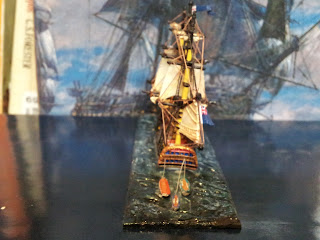In 1795, as part of its expansion after France and Holland became allies of France, the Royal Navy purchased nine 1,200-ton East India Company merchantmen then building on the Thames River. These ships were then converted to 54 or 56-gun warships by joining the forecastle and the quarter-deck (forming a continuous upper-deck). Armament for eight of the new vessels consisted of twenty-eight 18-pounder long guns on the gun-deck and twenty-six to twenty-eight 32-pounder carronades on the upper-deck.[4] They were classed as 'fourth-rates'.
The ninth vessel, the 56-gun HMS 'Glatton', became the Royal Navy's first (and only) warship armed exclusively with carronades. With twenty-eight 42-pounder carronades on her upper-deck and twenty-eight 64-pounder carronades on her lower-deck,[5] HMS 'Glatton' was a boarder's nightmare.
The first commanding officer of HMS 'Glatton' was Captain Henry Trollope (20.04.1756-02.11.1839) a veteran of the American War of Independence and a strong supporter of the use of carronades. Trollope would later command the 74-gun HMS 'Russell' at the Battle of Camperdown (11.10.1797).[6]
Probably the most famous commander of HMS 'Glatton' was Captain (later Vice-Admiral) William 'Breadfruit' Bligh (09.09.1754-07.12.1817). Bligh, who had served under Captain James Cook from 1776 to 1779, had been in command of HMAV 'Bounty' when the crew, led by master's mate Fletcher Christian, mutinied (28.04.1789). Bligh and 18 loyal crew members were set adrift in one of the ship's boats; 47 days and 3,618 nautical miles later they reached safety at the Dutch port of Coupang in Timor.[7]
Ironically, although Bligh held command of HMS 'Glatton' for less than a month (18.03.1801-12.04.1801) it was during this month that Vice-Admiral Horatio Nelson engaged the Danish Fleet at the Battle of Copenhagen (02.04).[8] The British victory cost the ship's crew 51 casualties (17 killed and 31 wounded). Bligh later received the personal thanks of Nelson for his conduct during the engagement.
HMS 'Glatton' was not in the line of battle at Trafalgar in 1805. She continued active service until 1814, when she was converted to a water depot. In 1830, HMS 'Glatton' was sunk as a breakwater.
The high-water mark of [William] Bligh's naval service was as Captain of HMS Glatton in the Battle of Copenhagen in 1801. Having spotted a Dutch frigate maneuvering to attack HMS Elephant, the flagship of Admiral Horatio Nelson, Bligh sailed directly into the line of fire and caught most of the enemy's broadside. The Glatton was severely damaged but remained afloat; the Elephant was saved.
Working on the standing rigging
Sails are on
Now for the running rigging. Notice that I am back to using thread. The horse hair is just too brittle and super glue doesn't stick to it well. I found that if I wax the thread before I apply it, I don't get the 'fuzzies' later on. I still use the horse hair for some applications, like towing ropes for boats.And finished

















1 comment:
Hi Vol,
I loved reading this piece! Well written!
Merlen Hogg
flexiskumm
Post a Comment